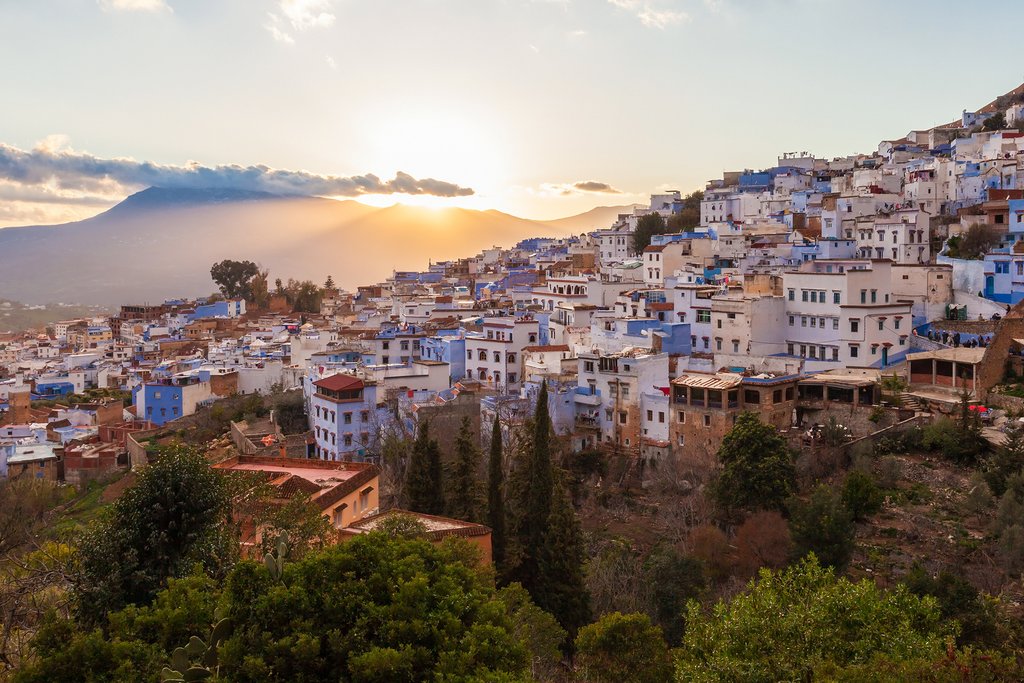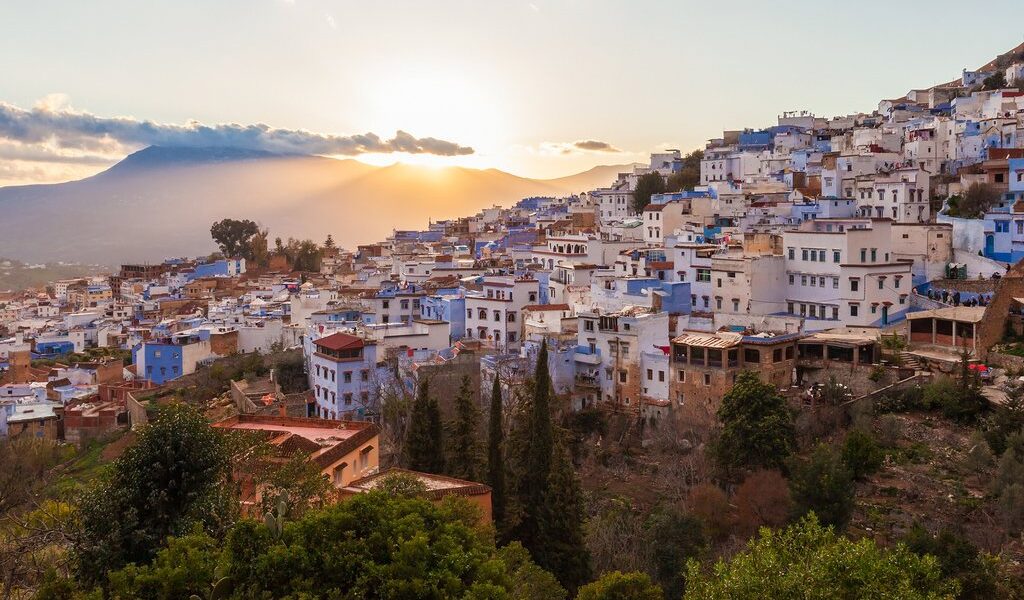
You probably know it from Instagram: the blue-washed streets of Chefchaouen are irresistibly photogenic. But nothing can compare to wandering through this hillside town on your own, discovering a medina cast in shades of azure and aquamarine. Use this handy overview to explore this northern Moroccan city.
## Immersing Yourself in the Azure Embrace of Chefchaouen
**Chefchaouen**, a name that translates to “two horns,” immediately evokes images of the majestic twin peaks that guard this captivating town nestled in the northern reaches of Morocco. While the official name resonates with its geographical setting, the locals affectionately shorten it to **Chaouen**, and travelers worldwide have lovingly christened it “The Blue City,” a testament to its distinctive aesthetic.
The secret of **Chefchaouen** has undeniably spread far and wide. In recent years, this enchanting locale has experienced a notable surge in tourism, fueled, in no small part, by the captivating and often ethereal images shared across various social media platforms. Despite its rising popularity, **Chefchaouen** has managed to preserve an atmosphere of tranquil authenticity. Perhaps it’s the dramatic landscape that cradles the town, or maybe it’s the pervasive calming effect of the azure hues that adorn its buildings, but the overall ambiance in **Chefchaouen** is undeniably more relaxed and serene than what one might typically encounter in bustling metropolises like **Marrakech** or the ancient city of **Fes**.
Historically, the region surrounding **Chefchaouen** has held deep spiritual significance for Muslims, primarily due to the revered tomb of Moulay Abdessalam Ben Mchich, the patron saint of the Jebali Riffian tribesmen. This spiritual legacy adds another layer of depth to the town’s identity. The late 15th century witnessed a significant demographic shift as the region welcomed an influx of Muslim and Jewish refugees fleeing Spain, further enriching the cultural tapestry of **Chefchaouen**. Until the recent surge in tourism, **Chefchaouen** remained largely untouched by the outside world, existing in a state of relative isolation. This isolation contributed significantly to the preservation of its unique character. To make the most of your visit to this truly remarkable destination, and to capture some unforgettable photographs along the way, consider the following detailed overview of **Chefchaouen** and its many hidden gems.
## Designing Your Perfect Chefchaouen Experience
**Chefchaouen** is indeed a town of manageable proportions. A well-planned itinerary of two days should comfortably allow you to explore its primary attractions and immerse yourself in its unique atmosphere. However, many visitors find themselves drawn to **Chefchaouen** not just for sightseeing, but also for relaxation and rejuvenation. Indulging in the traditional experience of a hammam, or embarking on invigorating hikes in the surrounding mountains, are popular activities that warrant extending your stay. If these activities appeal to you, consider adding a few extra days to your itinerary. For a comprehensive understanding of how to best allocate your time within **Chefchaouen** and across other captivating regions of Morocco, exploring detailed travel guides and resources is highly recommended.
The heart of your exploration will undoubtedly center around the compact medina, **Chefchaouen’s** old town. The medina is a labyrinth of narrow, winding alleyways, each turn revealing a new and captivating scene. You could easily dedicate half a day simply to wandering through these alleyways, losing yourself in the vibrant spectacle of brightly colored flower pots juxtaposed against the signature blue walls of the buildings. The photographic opportunities are endless! However, beyond the simple pleasure of aimless wandering, there are several key sights within the medina that are well worth seeking out.
At the lower edge of the medina lies the **Plaza Outa el Hammam**, the town’s principal square. This bustling hub derives its name from the numerous hammams that once encircled it, a testament to its historical significance as a center for relaxation and social interaction. Today, **Plaza Outa el Hammam** is lined with a diverse array of restaurants and cafés, making it an ideal spot for enjoying a leisurely meal or simply indulging in some people-watching. After savoring a cup or two of traditional Moroccan mint tea, venture into the nearby shops specializing in leather goods, carpentry, and textiles. Many travelers have noted that the shopping experience in **Chefchaouen** is often preferable to that in larger cities like **Fes** or **Marrakech**. The prices are generally more favorable, and the shopkeepers tend to be more relaxed and less insistent, creating a more enjoyable and authentic shopping environment.
One particular shopping experience that should not be missed is a visit to the legendary **Hat Man**. This unique and quirky emporium, located near the top of the medina on Rue Targui, is a treasure trove of hand-knitted hats in a dazzling array of shapes, sizes, and colors. It’s the perfect place to find a memorable and unique souvenir. For those seeking gourmet souvenirs, such as locally produced goat butter and mountain honey, a visit to **Plaza Hata** is a must. Afterwards, take some time to admire the elegant colonial architecture that graces the refined **Plaza el Makhzen**.
After a satisfying lunch of *tagine*, a quintessential North African stew comprised of slowly stewed meat and vegetables, at one of **Chefchaouen’s** many traditional eateries, make your way to the imposing **Grand Mosque and Kasbah**. The Grand Mosque, which was constructed by Moulay Mohamed in 1560, stands as the city’s oldest and largest place of worship. While non-Muslims are unfortunately prohibited from entering, as is the case with all Moroccan religious sites, the mosque remains a building of considerable architectural beauty and is well worth admiring from the outside. The *kasbah*, or old fortification, offers visitors the opportunity to explore a serene garden, a fascinating museum, and some of the historic prison cells that were used during the era of Spanish rule. Be sure to climb to the roof of the kasbah for a breathtaking panoramic view of the vividly colored buildings and the town sprawling below.
Next on your itinerary, head towards the refreshing **Ras el Ma** spring, which serves as the town’s primary source of water. Find a charming riverside café and settle in to enjoy another cup of revitalizing Moroccan mint tea. You might even be fortunate enough to witness local women engaging in the traditional practice of washing their clothes in the clear, flowing water. From the spring, follow the winding path that leads up the hill for approximately half an hour to reach the stark white **Spanish Mosque**. From this elevated vantage point, you can savor one last breathtaking view of **Chefchaouen** as the sun dips below the horizon, casting a warm golden glow over the mountains.
On your second day in **Chefchaouen**, consider embarking on a short drive to the starting point of one of the region’s enticing hiking trails. You have a choice between trekking along the river towards the magnificent **Cascades d’Akchou** waterfall, or venturing towards the naturally formed rock arch known as “The Bridge of God.” For particularly energetic adventurers, it’s even possible to conquer both hikes in a single day. Otherwise, plan on dedicating at least half a day to the journey to either of these stunning natural destinations.
## Reaching the Blue Pearl
**Chefchaouen** is conveniently accessible by a scenic drive from either **Fes** or **Tangier**. As you approach the town, nestled within the rugged Rif Mountains, the distinctive blue and red-tiled rooftops gradually emerge, creating an almost mirage-like effect. The journey from **Fes** typically takes around four hours, while the drive from **Tangier** is a little over two hours. If you are traveling from **Fes**, consider incorporating a brief detour to the impressive Roman ruins at **Volubilis**, which once marked the outermost reaches of the vast Roman empire. This historical site offers a fascinating glimpse into Morocco’s rich and diverse past.
## Optimal Timing for Your Visit
The ideal time to plan your trip to **Chefchaouen** is during the spring months, specifically from March to May. During this period, you’ll have a high likelihood of witnessing the vibrant display of wildflowers that adorn the landscape along the drive into and out of town, adding an extra layer of beauty to your journey. Alternatively, the months from September to November also present a compelling option. These shoulder seasons are generally considered optimal for travelers, as they typically offer a balance of pleasant weather, fewer crowds, and more affordable accommodation options.
## Selecting Your Accommodation
**Chefchaouen** offers a variety of charming accommodation options, ranging from traditional riads to modern hotels.
Ideally situated within the heart of the medina, the opulent **Lina Ryad and Spa** boasts spacious rooms and terraces that offer breathtaking views of the surrounding mountains. The hotel is exquisitely decorated with elegant arches, cozy fireplaces, authentic Moroccan textiles, and vibrant pops of blue that echo the town’s signature color. After a day of exploring and hiking, the heated indoor pool, indulgent baths, and traditional hammam provide the perfect opportunity to unwind and rejuvenate.
Several of **Chefchaouen’s** hotels are also home to some of the best restaurants in the city, offering guests a convenient and delectable dining experience. One such establishment is the medina classic, **Casa Hassan**. This charming hotel offers a choice of eight brightly colored rooms, as well as an additional 14 rooms at their sister hotel, **Dar Baibou**. Many of the rooms feature a working fireplace, adding a touch of warmth and romance, and all are uniquely decorated with beautiful tiles. Downstairs, guests can enjoy a traditional Moroccan lunch or dinner at the renowned **Tissemlal Restaurant**, which specializes in grilled meats, flavorful couscous, and mouthwatering tajine cooked over an open fire.
**Casa Perleta** is a highly-rated riad that is also located within the medina. This traditional Andalusian house has been meticulously restored with local art and tapestries, creating an atmosphere of authentic Moroccan charm. It features eight beautifully appointed rooms. Guests can linger over a traditional Moroccan breakfast, complete with fresh bread, homemade jams, and an assortment of fresh fruit, on the riad’s rooftop terrace, which offers stunning views of the medina below.
## Indulging in Local Flavors
**Chefchaouen** offers a diverse culinary scene, ranging from traditional Moroccan fare to international cuisine.
One of the most renowned restaurants in **Chefchaouen** is **Casa Aladdin**, which boasts unparalleled views overlooking the **Place Uta el-Hammam**. The restaurant’s house specialty is a delectable vegetarian *bastilla* (also known as *pastilla*), a traditional Moroccan dish that can best be described as a savory pie. Another dish worth trying is the anchovy tajine, a regional specialty.
The popular **Lala Mesouda** is celebrated for its homemade Moroccan cuisine, including exquisitely prepared tajines and excellent couscous. Some of their most famous dishes include local recipes such as *baqula* (a salad of cooked greens), *chardon* (artichoke thistle cooked in olive oil), and *sfarjel* (a mix of quince and beef).
For a quick and satisfying bite, head to **Restaurant Populaire** and grab a *bocadillo* (Spanish sandwich) from this beloved local sandwich joint. Be sure to try the “Tangier”—a mouthwatering, slow-cooked strip of tender beef seasoned with garlic, onion, and cumin, and smothered in a tangy yogurt sauce.
## Essential Local Tips for an Enriching Experience
**Chefchaouen** is more than just a tourist destination; it is a living, breathing city where people reside and go about their daily lives. It’s important to remember this and to be respectful when taking photographs of homes and posing on doorsteps.
Consider wandering through the streets early in the morning, before breakfast, to experience the town in its most peaceful state. You may even find that you have the entire place to yourself before the day-trippers arrive.
If you plan on hiking in the surrounding mountains, be sure to bring a bathing suit and trekking shoes that you don’t mind getting wet. The natural pools located up in the mountains are perfect for a refreshing dip when the weather is warm.
For the absolute best panoramic view of **Chefchaouen**, hike up the hillside, past the city gates, to the **Hotel Atlas**, where you’ll discover unbelievable panoramic views over the enchanting blue city.
B-1650

